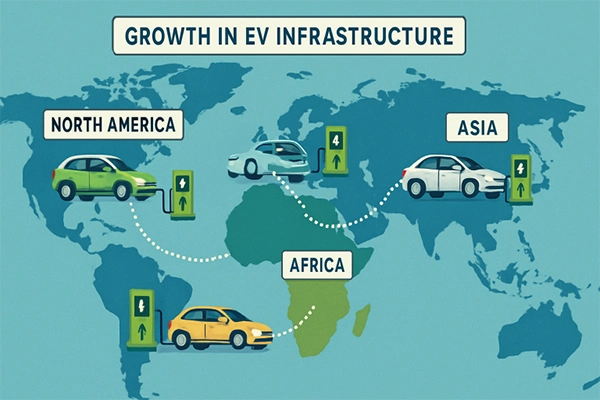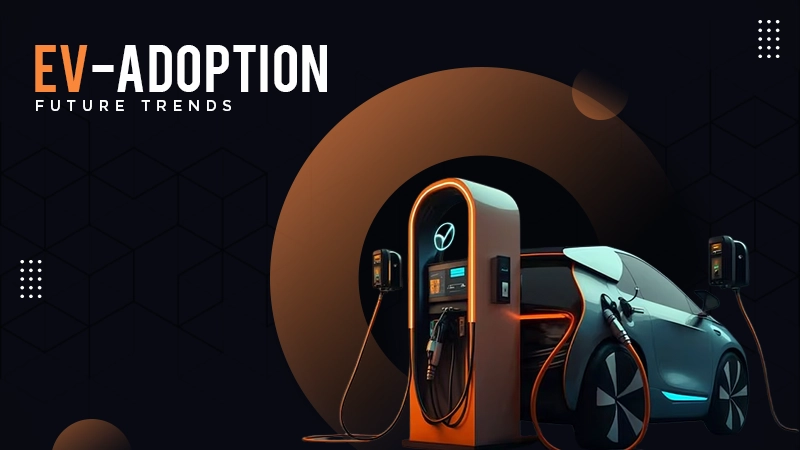Table of Contents
- Introduction
- Global EV Sales Trends
- Advancements in Charging Infrastructure
- Innovations in Charging Technologies
- Policy and Government Initiatives
- Challenges in EV Adoption
- The Role of Renewable Energy
- Future Outlook
The shift to electric vehicles (EVs) is gaining momentum worldwide, driven by technological advancements, climate goals, and supportive policies. As battery costs fall and vehicle range improves, more consumers are switching. However, the expansion of charging infrastructure is crucial to sustaining this growth. Public and private investments are being made to build faster, more accessible charging networks, including ultra-fast chargers and home-based solutions. Urban planning and smart grid integration are also key in meeting rising demand. As adoption accelerates, collaboration among automakers, governments, and energy providers will be essential in shaping a sustainable and efficient EV future.
Introduction
The rise of electric vehicles (EVs) signifies a pivotal moment for global transportation, reshaping energy consumption and reducing greenhouse gas emissions. With more countries and companies investing in greener transportation, the focus on practical, scalable charging infrastructure is intensifying. Relational solutions like Delta electric vehicle chargers are key to enabling this rapid evolution, and they are designed to meet the growing demand for efficient and accessible vehicle charging worldwide.
As governments encourage electrified transportation and consumers seek cleaner alternatives, advancements in vehicle technology and charging networks are critical. Public and private stakeholders alike recognize that building expansive charging stations isn’t just about infrastructure—it’s about shaping a sustainable future. Understanding the pathways to EV adoption helps inform industry decision-making and guides policy, investment, and research efforts toward viable long-term solutions.
Behind the surge in EV uptake are factors such as policy incentives, diversified model offerings, and lower total ownership costs compared to traditional vehicles. The role of dependable charging hardware and intelligent network management is drawing increasing attention. Infrastructure providers and technology leaders are working to eliminate range anxiety and accelerate the electrification of transport globally, making products like Delta electric vehicle chargers instrumental for bolstering the consumer experience and supporting network growth.
This comprehensive look at global EV adoption trends, future innovations, and the interplay with renewable energy highlights how the sector is developing—and what lies ahead for consumers and industry leaders.
Global EV Sales Trends
Global electric vehicle (EV) sales are accelerating rapidly, marking a significant shift in the transportation sector. In 2023, an estimated 14 million EVs were sold globally—an impressive 35% jump from the previous year. This surge is fueled by a combination of technological innovation, such as improvements in battery range and charging speed, along with a growing lineup of models catering to different price points and preferences. Government policies also play a critical role, with many nations offering incentives and setting strict emissions goals that favor EV adoption. According to the International Energy Agency, EVs now represent more than 20% of all new car sales worldwide, underscoring a fundamental evolution in how the world drives.
Advancements in Charging Infrastructure
Charging vehicles quickly and conveniently is essential for widespread EV use. By late 2023, more than 8 million public charging points had been deployed worldwide—up 40% from the year prior. China leads with 85% of the world’s fast and 60% of slow chargers, offering a model for rapid infrastructure deployment. In Europe and North America, efforts to densify charging networks are gathering pace, with strategic installations in urban and highway settings to maximize accessibility for all drivers. For a deeper understanding of these deployment dynamics, visit IEA’s analysis on EV charging trends.

Innovations in Charging Technologies
The next chapter for EV charging is written through technological breakthroughs that dramatically shorten charging times and offer greater convenience. Battery swapping stations, prominent especially in China, are slashing wait times by allowing users to exchange depleted batteries for fully charged alternatives quickly. Ultra-fast charging solutions, capable of delivering up to 400 kW, now provide the capability to charge an EV to 80% capacity in less than 20 minutes. These innovations transform the EV ownership experience and are positioned to become standard offerings as manufacturers ramp up deployment.
Policy and Government Initiatives
Legislative mandates and incentive programs remain crucial to accelerating infrastructure growth and ensuring accessibility. The European Union’s Alternative Fuels Infrastructure Regulation mandates high-speed chargers every 60 kilometers along major routes by 2025, creating an uninterrupted network for long-distance journeys. Meanwhile, the United States targets 500,000 accessible public chargers by 2030 as part of the Infrastructure Investment and Jobs Act, signaling a sustained federal commitment to decarbonize transportation and foster innovation at every level.
Challenges in EV Adoption
Despite the significant progress, several challenges hinder the full realization of EV potential. Consumers report concerns around vehicle cost, limited range, and inadequate access to charging stations—collectively known as “range anxiety.” In the U.S., for example, EVs represented only about 10% of new car sales in 2023, underlining these barriers’ enduring impact. Addressing these obstacles is essential, requiring technological innovation, equitable policies, and consumer education. For more strategies to address these challenges, refer to AP News’ coverage on EV adoption challenges.
The Role of Renewable Energy
Electric vehicle charging infrastructure’s true sustainability emerges when powered by renewable sources. Grid-integrated solutions enable EV stations to harness solar and wind energy, notably reducing the sector’s carbon footprint. An exemplary case is Electrify America’s Solar Glow 1 initiative in California, which generates 225,000 megawatt-hours of clean power annually, supporting the equivalent of over 20,000 households. Such projects underline the importance of synergy between transport electrification and renewable energy transition, fostering a virtuous cycle of emissions reduction and energy independence.
Future Outlook
The long-term outlook for EVs is robust, with forecasts projecting that electric cars could comprise 40% of all global car sales by 2030. Rapid infrastructure expansion, technological innovation, and strong regulatory support bode well for the industry’s trajectory. Emerging battery chemistries and the integration of innovative charging management systems will further boost efficiency and convenience, enhancing the total value proposition for consumers.With continued collaboration between public and private sectors, and a steadfast focus on sustainability, the electrification of mobility is set to transform economies and communities everywhere. For comprehensive reports and data, refer to the International Energy Agency’s Global EV Outlook 2024 and emerging perspectives on charging infrastructure via EV Magazine’s analysis on EV charging trends.





